Formation of periodic and quasiperiodic optical patterns
Quasipatterns
Periodic planar patterns have a translational symmetry and an N-fold discrete
rotational symmetry with N=2,3,4 or 6. The typical structures, stripes,
rhombi, squares and hexagons, have been investigated in dissipative systems
for several years. N-fold rotational symmetries with N=5 or N>6 are incompatible
with translational symmetry. Therefore the corresponding structures are
not periodic, but quasiperiodic. These quasipatterns have been predicted
to occur in a large variety of dissipative systems with initial O(2) symmetry.
Their general properties have been the subject of considerable theoretical
interest.
Experimental evidence, however, has been limited to the Faraday experiment,
i.e. to a parametrically excited hydrodynamical system. In the Faraday
system, however, their observation has been restricted to a fairly special
situation, close to a codimension-two point. Furthermore, quasipatterns
have been observed in optical systems upon which a discrete rotational
symmetry was imposed externally.
In our group, the formation of quasipatterns in an optical system with
continuous rotational symmetry is investigated. The experimental system
is built from a nonlinear medium and a single mirror. The nonlinear medium
is sodium vapor in a buffer gas atmosphere (nitrogen) which is contained
in a heated cell. The medium is irradiated by the carefully spatially cleaned
Gaussian output beam of a dye laser which is tuned to a frequency slightly
above the frequency of the sodium D1-line. The light is circularly polarized
and represents sigma-plus-light with respect to the quantization axis defined
by a weak longitudinal magnetic field. The transmitted light is fed back
into the medium by a single plane mirror placed at a distance d of about
80 mm to 150 mm behind the medium. Within the feedback loop there is also
a quarter-wave plate which inverts the helicity of the circular polarization
so that the polarization of the feedback beam has a circular polarization
opposite to the one of the input beam. This changes the saturation
characteristics such that rather wide patterns can be obtained.
| Transverse profile of the laser beam |
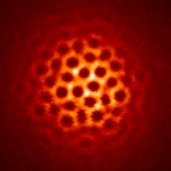 |
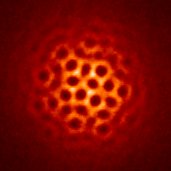 |
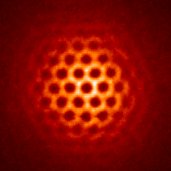 |
| Fundamental Modes |
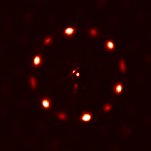 |
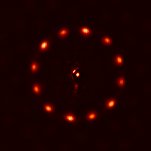 |
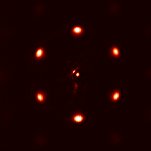 |
|
Quasipattern |
12-fold Quasipattern |
Hexagon |
In this system we observe twelvefold quasiperiodic structures. These
quasipatterns arise from a primary hexagonal structure. In dependence on
the experimental parameters the bifurcation can be sub- or supercritical.
In the supercritical case, the transition is mediated by a new kind of
patterns with different amplitudes in its fundamental modes. It has been
proven by an optical Fourier filtering technique that the observed quasipatterns
can only exist in the presence of harmonics of the fundamental unstable
modes.
Superlattices
Superlattices are patterns which are more complex than the 'simple'
periodic patterns (stripes, squares, hexagons) but - in contrast to the
quasipatterns - preserve the periodicity. They contain multiple length
scales, e.g. small elementary cells, which already display some symmetry
and order, and which are repeated periodically, see the example:
Very little is known about the properties of spontaneously generated
superlattices. The possibility of their existence and their classification
follows from group theoretic arguments (see
references for more information). In rotational
symmetric systems they were recently observed in the Faraday
instability and in our system.
Investigations of the linear stability properties of the large-amplitude hexagonal solution are carried out in collaboration with Dr. P. Colet (IMEDEA; Palma de Mallorca, Spain) and Dr. D. Gomila (University of Strathclyde, Glasgow, Scotland).
 List of publications List of publications
|

